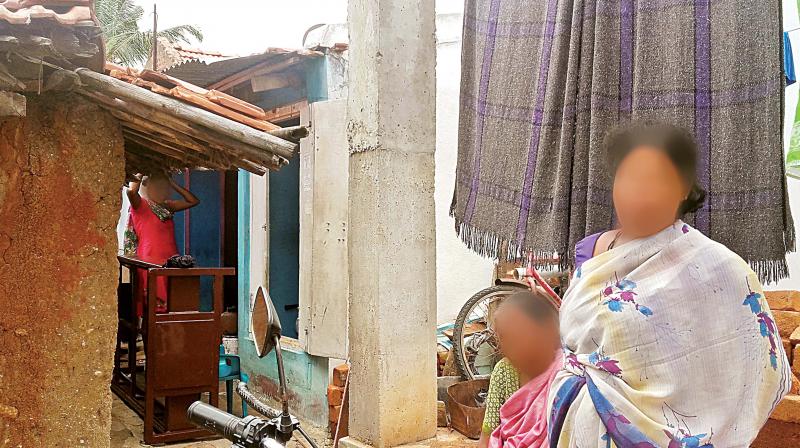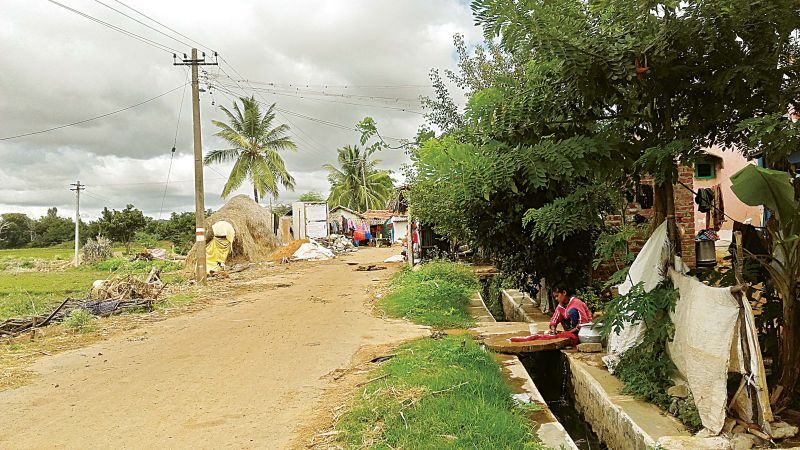Sunday story: No salvation for the young brides of Hosalli
There have been at least 16 child marriages in Hosalli Mole, 13 in Moogur Mole, three in Kannaiah Mole in the recent past.

A nation was traumatised and found itself in a serious dilemma after reports recently emerged of a 10-year-old rape survivor delivering an underweight baby after being refused the right to abortion by the Supreme Court. The top court was concerned over the implications of an abortion on a minor girl but here’s a shocker from our own Mysuru, Chief Minister Siddaramaiah’s home district – these are not rape cases, girls get married and deliver before 18 in what is a regular occurence with the blessing of the whole village! The health implications, the fact that they are breaking sacrosanct laws of the land, hardly matter to the villagers of Hosalli Mole in T Narsipur taluk, for whom tradition matters most, and the bane of dowry, rape and even secret love affairs is something too fearful too handle. Shilpa P. visits these villages where no Bhagyas have been able to make inroads, where young girls turn physical and mental wrecks even before 18, unable to cope with the pressures of motherhood.
“Who said I am married?” asks 16-year-old Niveditha (name changed), her cherubic face lighting up with a naughty smile. The young girl is now the ‘proud’ wife of her mom’s younger brother after she was recently married off secretly by her parents, at a temple in a far-off village. She had hastily removed her toe ring and mangalsutra, revered symbols of marriage, soon after the news spread in the village of 120 dwellings, 51 km from Mysuru, about the arrival of the media team.
Like most Indian villages, Hosalli has not been blessed with good roads, or other facilities, there are no private or KSRTC buses connecting it to the rest of the world in what is ironically a part of public works minister Dr H.C. Mahadevappa’s constituency. A narrow sludge filled road, cattle jostling for space in the front yards of tiny dilapidated houses and the reeking poverty all around, says a lot about why the villagers clutch to their obscure practices like a lifeline.
And what was it that made the family marry off skinny Niveditha, who is hardly four and a half feet tall, to her uncle when she has hardly come to terms with the changing biology of a teenager? Her young mother Susheelamma (name changed) who was married at the age of 12, comes out running to the rescue of her daughter saying, “I am blessed with a male baby in the family at last, after three girls. I have to take care of the infant for which Niveditha stays at home to help me and the baby. There are no buses in this village, if she has to go to school, she will have to walk three km to the high school in Moogur. With a perpetual drought in the region, we frankly don’t have the money to spend on her educational expenses,” she smiled. Niveditha may soon become a mother but Roopamma, an Anganwadi worker at Hosalli, blushes when she discloses that she is already a grandmother at 35! These are no exceptions, it is the same, pathetic tale of almost every girl, every young mother and grandmother in every household in Hosalli Mole, nearby Moogur Mole and Kannaiah Mole. It all boils down to the abysmally low social status a girl child has to contend with in rural India, in remote, underdeveloped places like Hosalli. No one knows of the law banning child marriage in these villages-or does not care to know for it would make girls like Niveditha an unbearable burden for them, making it impossible to marry off minor girls.
There have been at least 16 child marriages in Hosalli Mole, 13 in Moogur Mole, three in Kannaiah Mole in the recent past according to sources in the women and child development department. But police records for the entire district say there were four cases of child marriage in 2015, six in 2016 and five so far this year (Mysuru city had two cases each in 2015, 2016 and 2017).

“The practice is rampant in the Uppar Shetty community in these villages. Even in this age, it is the village head (Yajamaanaru) who decides on any issue. Even though we warned the village heads that they would be punished if they allow a child marriage, they say it’s a custom in their community” reasoned T Narsipur Child Development officer Basavaraj B.N.
“A girl child is a Lakshmi no doubt, we would not like to consider her a burden. But from age immemorial, it is a custom in our community to name a bridegroom or find one later once a girl child is born, and get her married before she attains puberty. If she crosses 15, she has to marry a widower or divorcee, or else remain unmarried for the rest of life. We have a few such girls who are unmarried in our village. We know of the law, we will try to get them married only after they complete 18,” village head at Moogur Mole, Madevshetty (name changed) said.
“You people come here questioning child marriage, what do you know about our problems as parents of a girl child? Earlier, it was said that since the female sex ratio was low, bridegrooms paid money to marry girls. But now, with increasing dowry and the drought staring at us, getting a girl married is a costly affair. If the girl is fair, the less the dowry, if she is dark, it will inevitably be more. The dowry will depend on her education, status and the bridegroom’s job. The drought has made the situation unbearable; most villagers have to migrate to Kodagu or Mysuru for jobs. Rice under Annabhagya is hardly of any use, we are used to having rice from the paddy grown in our own fields,” explained Susheelamma.
For the gullible villagers, reports of child rape and girls eloping with lovers putting them to shame, has only made them consider child marriage like a blessing from the heavens. “We want to be relieved of our responsibilities as fast as possible,” Susheelamma defended. There have been 43 cases of child rape in Mysuru district in 2015, 78 in 2016, and 56 so far in 2017. As for cases of children going missing which are considered as kidnap, there were 44 cases in 2015, 110 in 2016 and 48 this year. “Most of the kidnap cases filed with us are actually those of girls eloping with boys,” said a police source explaining why the villagers are so fearful of keeping a grown-up girl in the house. “You say marrying young is bad for the girl's health. Even we were married young, our ancestors got married at the age of seven and had 12 to 16 children. We all had normal deliveries,” said Suchithra (name changed), a young mom from Kanhalli mole.
Are those who get married young, dying early because of the burden of pregnancy and child birth? The maternal mortality rate in Mysuru district is a comfortable 50 per lakh in 2016-17 compared to the national average of over a hundred but is still a matter of concern. In 2016-2017, there were 40,800 births in Mysuru district with 20 mothers dying during delivery including one from T Narsipur, according to the health department. In the same period, 427 infants have died in Mysuru district, including 38 in T Narsipur. But statistics usually hide more than what they reveal. Will Mysuru ever be able to stop child marriage? “The times are changing. Earlier, there were hardly any girls who went to high school or beyond, now we have a few doing their degree course in these villages,” said an Anganwadi worker.
“I won’t get married young, I want to study like those in cities, achieve something in life and take up a good job so that my parents do not have to pay dowry. A day may come again when men may have to pay to marry girls,” quipped Apoorva (name changed) a class 8 student from Moogur mole, her wide eyes sparkling with hope and the dream of a new beginning. For these simple, untainted villagers, the shadows of poverty and tradition, cast over a hundred generations, are hard to erase but the winds of change are definitely blowing strong with those like Apoorva leading from the front. Sometime in the future, young girls from Hosalli will have to thank gritty youngsters like her, for refusing to bow before an inflexible village elder and for saving them from the vagaries of a child marriage.

